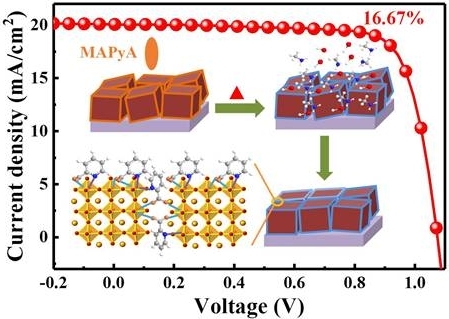
A research group led by Prof. FANG Junfeng at the Ningbo Institute of Materials Technology and Engineering (NIMTE) of the Chinese Academy of Sciences (CAS) has synthesized an effective post-treatment agent of methylammonium pyridine-2-carboxylic (MAPyA) to in situ heal and stabilize CsPbI3 films for high efficiency and stable inverted CsPbI3 perovskite solar cells (PSCs).
The fabricated devices showed a champion efficiency of 16.67%, which is the highest efficiency reported for inverted CsPbI3 PSCs so far. The study was published in ACS Energy Letters (ACS Energy Lett.).
Inorganic perovskite CsPbI3 semiconductors, featuring superior photoelectric properties and excellent thermal stability, reveal promising application in high-performance photovoltaic devices, especially as the top cell in tandem structure. However, due to the uncontrolled crystallinity and phase transition for CsPbI3 films, fabricating stable and efficient CsPbI3 perovskite solar cells (PSCs) is still challenging.
The researchers at NIMTE proposed the in situ healing and stabilizing post-treatment to address the Voc loss and phase transition issues of CsPbI3 films in inverted iPSCs.
When annealed at 100 °C, MAPyA on CsPbI3 degrade into methylamine (MA) gas and pyridine-2-carboxylate (PyA-), and MA remove pinholes, while PyA- gifts effective passivation. In addition, oriented PyA- anions hinder phase transition and isolate external erosions for long-term stability.
After the MAPyA treatment, the optimized devices showed great efficiency improvement from 11.23% to 16.67% with the Voc improved from 0.98 V to 1.074 V, which is the highest efficiency for inverted CsPbI3 PSCs reported to date.
Moreover, the modified devices revealed an excellent stability improvement. The target device remained its almost initial efficiency (97.5%) after being stored in N2 filled glovebox for 120 d. The tolerance of humidity and heat of the optimized devices also saw significant improvement.
More importantly, the unpackaged device still retained 81.31% of the initial efficiency after 1,800 min of outdoor operation in ambient condition with relative humiduity (RH) of 30%, which was the first report that realized long-term operational stability under ambient condition with the unpackaged I-rich inorganic PSCs.
The study has offered a simple but effective strategy to fabricate highly efficient and stable inverted CsPbI3 PSCs, and promoted its promising application and commercialization.
This work was supported by the National Natural Science Foundation of China and the Key Research Program of Frontier Sciences, CAS.

The fabricated inverted CsPbI3 PSCs with efficiency of 16.67% (Image by NIMTE)

86-10-68597521 (day)
86-10-68597289 (night)

86-10-68511095 (day)
86-10-68512458 (night)

cas_en@cas.cn

52 Sanlihe Rd., Xicheng District,
Beijing, China (100864)

